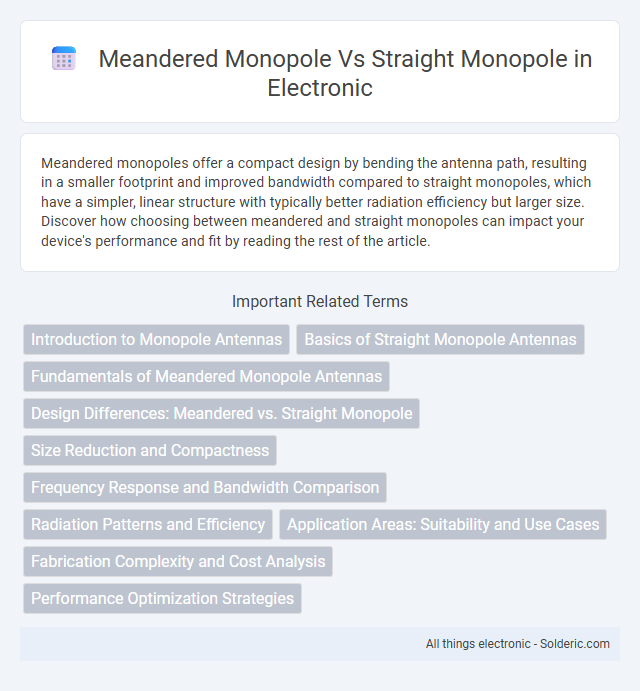Meandered monopoles offer a compact design by bending the antenna path, resulting in a smaller footprint and improved bandwidth compared to straight monopoles, which have a simpler, linear structure with typically better radiation efficiency but larger size. Discover how choosing between meandered and straight monopoles can impact your device's performance and fit by reading the rest of the article.
Comparison Table
| Feature | Meandered Monopole | Straight Monopole |
|---|---|---|
| Size | Compact, reduced physical length | Longer, proportional to quarter-wavelength |
| Bandwidth | Narrower bandwidth | Wider bandwidth |
| Resonant Frequency | Lower frequency for given length | Higher frequency, standard length |
| Radiation Efficiency | Lower due to losses in bends | Higher efficiency, simpler geometry |
| Polarization | Linear polarization | Linear polarization |
| Fabrication Complexity | Higher complexity, precise bends | Simple fabrication |
| Applications | Size-constrained devices, compact antennas | General applications, wideband systems |
Introduction to Monopole Antennas
Monopole antennas, fundamental in wireless communication, come in straight and meandered designs, each influencing antenna size and performance. A straight monopole offers simplicity and efficient radiation but requires more physical space, while a meandered monopole uses a serpentine path to reduce size without drastically compromising frequency behavior. Your choice between the two impacts the antenna's bandwidth, resonant frequency, and applicability in compact devices where space constraints are critical.
Basics of Straight Monopole Antennas
Straight monopole antennas consist of a single, straight radiating element typically one-quarter wavelength long, mounted perpendicular to a conductive ground plane. They exhibit omnidirectional radiation patterns with relatively simple design and predictable impedance characteristics, making them widely used in mobile and base station applications. Meandered monopoles achieve size reduction by introducing bends or folds in the element, but straight monopoles maintain better efficiency and bandwidth due to their uniform current distribution.
Fundamentals of Meandered Monopole Antennas
Meandered monopole antennas achieve compactness by introducing a serpentine or zigzagging current path, effectively increasing electrical length without enlarging the physical size. This design enhances bandwidth and resonance control compared to straight monopole antennas, which have a linear current path and rely on physical length for frequency tuning. Understanding the current distribution and impedance characteristics of meandered structures is crucial for optimizing Your antenna's performance in size-constrained applications.
Design Differences: Meandered vs. Straight Monopole
Meandered monopole antennas incorporate a zigzag or serpentine pattern to reduce the overall length while maintaining resonant frequency, offering a compact design ideal for space-constrained applications. Straight monopole antennas feature a linear, vertical structure that provides simpler fabrication and broader bandwidth but requires more physical space. Your choice depends on balancing size constraints with performance needs, as meandered designs optimize miniaturization and straight monopoles maximize efficiency and ease of manufacturing.
Size Reduction and Compactness
Meandered monopoles offer significant size reduction and enhanced compactness compared to straight monopoles by folding the antenna element into a serpentine shape, effectively increasing the electrical length within a smaller physical footprint. This design approach enables better miniaturization, making meandered monopoles ideal for applications requiring compact antennas without sacrificing resonant frequency. Despite their smaller size, meandered monopoles maintain adequate bandwidth and radiation performance, balancing the trade-offs in compact antenna design.
Frequency Response and Bandwidth Comparison
Meandered monopole antennas exhibit a lower resonant frequency compared to straight monopoles of the same physical length due to their effectively increased electrical length, enabling compact designs without sacrificing performance. The meandering introduces multiple current paths, resulting in a wider bandwidth and improved frequency response suitable for multiband applications. Your choice between these antennas depends on the space constraints and the desired bandwidth efficiency for optimal frequency performance.
Radiation Patterns and Efficiency
Meandered monopole antennas exhibit more compact physical sizes compared to straight monopoles, resulting in altered current distributions that create more complex and often less uniform radiation patterns. The meandering introduces multiple resonances and can cause reduced radiation efficiency due to increased conductor losses and surface wave excitation. In contrast, straight monopoles provide more predictable omnidirectional patterns and typically higher radiation efficiency, benefiting from a simpler current path and reduced conductor losses.
Application Areas: Suitability and Use Cases
Meandered monopole antennas are ideal for compact devices and applications requiring miniaturized antenna designs, such as wearable technology and IoT devices, due to their reduced size and better space efficiency. Straight monopole antennas are better suited for applications demanding higher radiation efficiency and broader bandwidth, like base stations and radio communication systems. Your choice depends on the balance between size constraints and performance requirements in specific use scenarios.
Fabrication Complexity and Cost Analysis
Meandered monopoles feature a serpentine geometry that reduces antenna size, leading to increased fabrication complexity due to tighter etching tolerances and precise bending angles, often resulting in higher production costs compared to straight monopoles. Straight monopoles, with their simpler linear structure, offer straightforward manufacturing processes, lower material waste, and reduced tooling expenses, making them more cost-effective for mass production. The trade-off involves balancing the compactness and performance benefits of meandered designs against the simplicity and economic advantages of straight monopole fabrication.
Performance Optimization Strategies
Meandered monopole antennas optimize performance by increasing the electrical length within a compact physical space, enhancing resonance and bandwidth without enlarging the antenna size. Straight monopole antennas rely on physical length for resonance, often requiring more space and limiting miniaturization for frequency tuning. Design strategies for meandered monopoles include careful adjustment of the meander pattern and spacing to maximize radiation efficiency and impedance matching, crucial for improving antenna gain and reducing signal loss in compact wireless devices.
meandered monopole vs straight monopole Infographic

 solderic.com
solderic.com